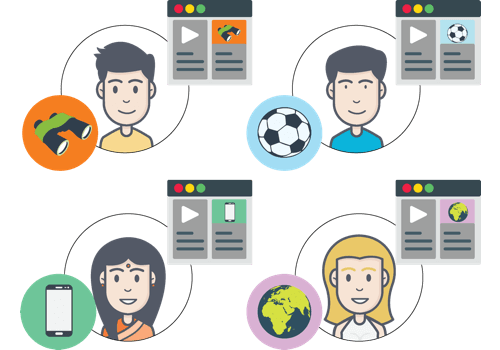What is dynamic content?
Dynamic content is a type of smart content that is called from pre-defined fields and attachments and has provided the possibility of great diversity. In the production of dynamic content, the data does not need to be entered manually, but the data is entered directly from the spreadsheet or CSV. On the other hand, you can use the most useful spreadsheet programs and generate data more quickly. The data is automatically converted into a table. Table variables are used, and different questions are prepared.
What is dynamic content? Dynamic content is also called dynamic content. In creating content for websites, instead of using the same element in different places on the website, the same element can be dynamically defined once. In this way, with just a few clicks, the desired element is added to different parts of the website. Dynamic content is divided into three different sections: “Session Behavior”, “User Properties,” and “User Data.”
Behavior in the session: In dynamic content, the behavior in the session is displayed in the form of “content changes based on the pages users visit, ” time users spend on the site,” and “items users add to the shopping cart.” will be
User characteristics: In dynamic content, the content is categorized based on demographics and matches the personality of the buyers.
User data: Content changes based on previous user data, including customer interactions, customer lifecycle, and previous purchases.

What is the difference between static content and dynamic content?
Static content, like dynamic content, is part of a website page, except that static content, after being delivered to users, is stored on the main server and remains intact. Static content is also called static content. Newspapers and magazines are all static content, and there are no conditions to change them after printing. HTML files and images are sometimes stored as static content on the main server. Dynamic content is the content of websites that users change. A dynamic web page is never fixed and static but changes with user interaction.
In the initial steps of designing websites, static content is used. Implementing static content is easier and more convenient than dynamic content. Unfortunately, static content is impersonal; hence, website performance decreases. The use of high-quality dynamic content along with static content contributes to the development of the website and its visibility. Using dynamic content along with static content makes the website more user-friendly and reduces content maintenance costs. In addition to the mentioned items, the websites’ bounce rate, conversion, and return visits are also improved.
What are the benefits of dynamic content?
One of the benefits of dynamic content is informing users and audiences. For example, let’s say you have entered an online shop and you are viewing products related to users’ recent searches. Hence, users and audiences can see best-selling products and services. The impact of dynamic content on sales and digital marketing is noticeable. Another advantage of dynamic content is the creation of attractive templates and platforms based on the needs of users and audiences. Dynamic content is more flexible than static content. The use of dynamic content reduces the cost of updating websites and increases the speed of updating websites. At the same time, the process of updating static content is time-consuming and costly.
By using dynamic content, you can create a template for email notifications to users and audiences. In this case, users and audience can follow the email content. Dynamic content is more effective than static content. In addition to the impact of dynamic content on sales, we see an increase in the capacity of information stored on the website. It goes without saying that the amount of information stored on static websites is less than on dynamic websites. Dynamic websites have provided the possibility of optimal management of all types of content. Considering all the advantages mentioned, dynamic sites and dynamic content can be improved.
What are the disadvantages of dynamic content?
One of the disadvantages of using dynamic content on websites is the use of proper hosting and strong servers because the speed of loading and uploading on a dynamic website must be high. On the other hand, website coding standards must be fully and comprehensively followed to use dynamic content. Unfortunately, if the website coding is not strong and satisfactory, the end result will be unacceptable. It was mentioned earlier that dynamic websites cost more than static websites because preparing and publishing dynamic content for dynamic websites requires high time and cost.
Of course, due to the high flexibility of the dynamic website, saving time and saving the cost of updating dynamic websites, dynamic websites, and dynamic content are worth spending extremely high costs.
Investigating the impact of dynamic content on Google display ads
The increase in marketing with dynamic content production has promoted the use of dynamic content on Google display ads. In the past, the display of Google ads was the same and fixed for all audiences and users, but today, the situation has changed. Today, the display of Google ads has become dynamic, and according to the needs of each audience and user and taking into account their interests, dynamic ads are displayed. Simply put, Google analyzes the data received from each user, personalizes display ads, and makes the right products and services available to users. The proposed products and services are coordinated and related to the search history of users and audiences.
Using dynamic content in display ads has many advantages for advertisers. The increase in marketing is evident in the production of dynamic content in the display of advertisements. You should consider the features of Google and SEO when executing the content production order.

Applications
The tricks of dynamic content for sales should be observed in the produced content. In the digital marketing environment, dynamic content can be used to design information emails, introduce products and services that users and audiences like, display online advertisements, and advance the goals of business owners. Types of dynamic content are used in Internet marketing. Internet marketing with dynamic content is used for both users and sellers of products and services. In addition to the fact that online businesses use all kinds of dynamic content to advance their goals, they also benefit from dynamic content in the expansion and prosperity of their business and increasing the sales of their products and services.
How to implement dynamic content?
There are many solutions for implementing dynamic content. This can either be done in completely custom ways that require you to have development resources and time (usually, most companies don’t have these resources), or you can use third-party software to set up some dynamic content samples inside your website quickly. tick
One of these software is Omniconvert.com; to use it, you must first register an account, create an A/B test, and create your own dynamic content in the WYSIWYG editor by selecting the items you want to customize.
Key tools in the production of Dynamic Content
To produce dynamic content, we need a series of key tools that must be available to us; these tools are:
Centralized Marketing Database
This database is the mastermind of dynamic content production and can store your audience statistics. (Anything including downloads, history of visiting web pages, etc.)
Adaptability to geographic location
dynamic content is largely dependent on your geographic location or location. You should better identify the user’s needs by recognizing the user’s geographical location and providing him with more suitable suggestions.
Easy-to-edit pages
A dynamic website is a site where you can easily edit its pages.
Intelligent content generator
Dynamic content is formed based on data and a set of rules, also called intelligent content; this content hides or shows a part of the images, which makes this decision based on the information obtained from the centralized marketing database.

Integrated Email System
Dynamic content doesn’t have to be limited to your site. You can add it to the email that is going to be sent to your audience and know that based on a series of new research, personalized emails increase the conversion rate by 10% and the click rate by 14%!
Retargeting
Dynamic targeting involves showing your content to people who have previously visited your website or used your app on their mobile phones. This update type is dynamic and encourages potential customers to communicate with you.
Offering based on past behavior
This is also done based on the information from the centralized marketing database. In this way, you discover their unique needs and desires by using the recorded history of the audience’s or customer’s behavior.











